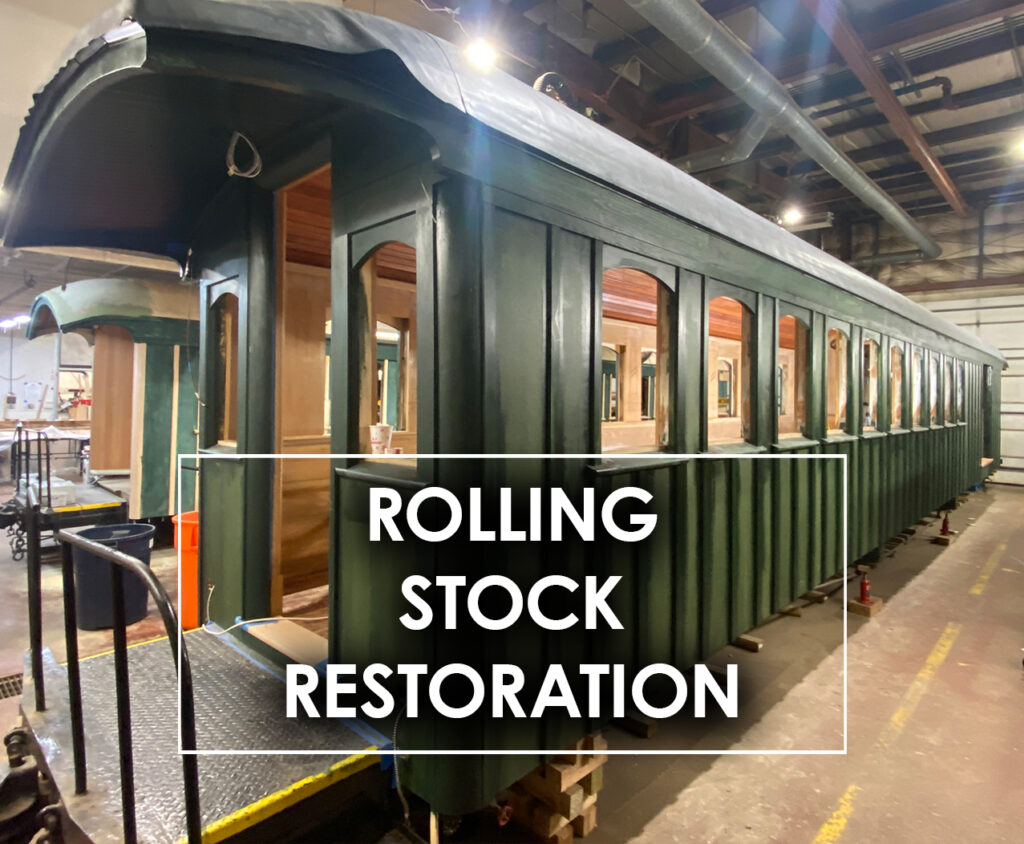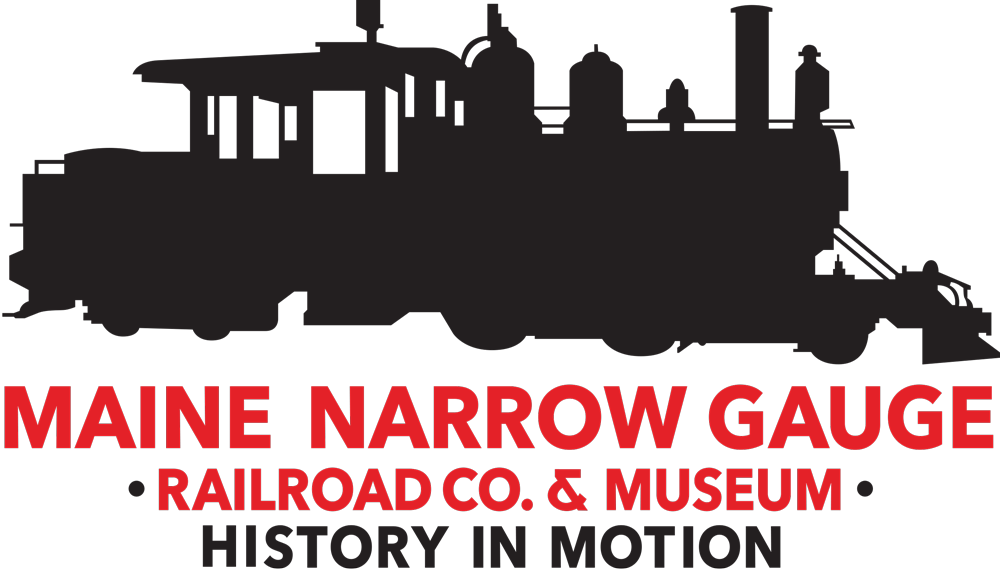Maine Narrow Gauge performs the majority of our restoration work in-house. Volunteers work alongside staff to share and learn techniques that not only bring the past to life, but also “wow” today’s guests and visitors.
You can play a vital role in preserving and restoring our collection of highly rare two-foot gauge railroad equipment. Financial donations are always appreciated and help our restoration team to have the tools and know-how to accomplish almost any job.
You can also join Maine Narrow Gauge to get opportunities to volunteer. Volunteers get plenty of time for hands-on restoration work. We teach restoration skills to volunteers from all backgrounds and experience levels.
CLICK HERE to learn more about volunteering with Maine Narrow Gauge.

Monson steam engine #4 AND Bridgton & Saco River steam engine #8 will be FULLY RESTORED to active service!
Maine Narrow Gauge is partnering with Maine Locomotive & Machine Works to completely and accurately restore former Monson Railroad #4 and Bridgton & Saco River Railroad #8 to steam again. Both of these steam engines will be placed into active service upon completion of their restoration work.
These two survivors of Maine’s two-footer railways are especially relevant in Maine history, and both played vital roles in helping develop Maine’s remote interior.
- Monson #4 was built in 1918 by Vulcan Iron Works for the Monson Railroad. It spent its working life hauling slate, passengers, and freight on the six-mile Monson Railroad. After that railroad’s closure in 1943, Monson #4 went to the original version of the Edaville Family Theme Park. It stayed there for nearly 50 years before coming to Portland when Maine Narrow Gauge was formed. #4 worked our waterfront line in the early 2000s, but was withdrawn from service in 2014 because it required a new boiler. Since 2019, #4 has been located offsite, waiting for the day it can steam again.
- Bridgton & Saco River Railroad #8 was built in 1924 by the Baldwin Locomotive Works. It was the last, largest, and heaviest of the steam engines built for the Bridgton & Saco River. It spent its working days carrying passengers and freight between Bridgton and Hiram, Maine, where the narrow gauge railroad had a connection with the standard gauge Maine Central Railroad. The Bridgton & Saco River Railroad (later renamed the Bridgton & Harrison Railway) closed in 1941. #8 enjoyed a second life at the Edaville Railroad, until the original version of the Edaville Railroad closed in 1991. #8 was returned to Maine as part of the inaugural Maine Narrow Gauge Railroad Company & Museum Collection. Since the expiration of its boiler certificate, the locomotive has been stored offsite, awaiting a new boiler and additional restoration work.
Monson #4 and Bridgton & Saco River #8 are expected to be fully restored and placed into operation by the early 2030s. It is our mission and our privilege to bring not just one, but two steam engines back to life, so that they can continue to inspire and educate for many generations to come.
Upon completion of the restoration work, Maine Narrow Gauge will be one of the few railroads in the country to have our entire roster of steam engines in active service. We are grateful and incredibly excited for the future of steam-powered two-foot gauge railroading!
YOU can help return these engines to steam! Consider making a donation in support of our steam operations. As a non-profit org, Maine Narrow Gauge relies on financial support in order to restore equipment and offer year-round programming. Opportunities to participate in the restoration work will be available to qualified Maine Narrow Gauge members.
Keep checking our website and follow our social media, as well as Maine Locomotive & Machine Works for the latest news and info.

Maine Narrow Gauge aims to complete 2-3 complete restoration projects per year on our equipment. These range from freight cars to historic passenger coaches, and even newer-build passenger cars.
Donations help ensure that we have the resources to complete restoration projects in a timely manner, and that our restoration team has access to the best tools possible to perform the best work possible.
Currently, the Restoration Shop is restoring:
- Ex-Edaville Coach #23: Built in 1958 for the Edaville Railroad and acquired by Maine Narrow Gauge in 1992, this coach has become a reliable part of our fleet for generations of passengers. This winter, we took it out of service to repair weathered woodwork and prepare it for safe, continued use on our operating railroad.
- Ex-Edaville Coach #25: this enclosed coach was built in 1973 at the Edaville Railroad in South Carver in the 1950s, Massachusetts. It was built to match the style of historic two-footer passenger cars that Edaville already owned. It was frequently used on Maine Narrow Gauge trains after having arrived in Portland in the 1990s. It is currently being restored and transformed into our first-ever Presidential Class car. This car will offer unmatched comfort and exclusive passenger amenities when restoration work is completed.
- Bridgton & Saco River Railroad Boxcar #62: One of only two original boxcars from the Bridgton & Saco River known to survive, #62 was built in the 1880s and rebuilt by the railroad in 1906. Over the years it fell into disrepair, but thanks to donor-funded materials and volunteer support, we’ve replaced both end beams and made it structurally sound for the next phase of restoration. Once complete, this boxcar will be one of the few surviving examples of two-foot freight equipment in the country.
Recent completed Restoration Projects include:
- Open-Air Car #102: this open-sided car was built in 1971 at the Edaville Railroad in South Carver, Massachusetts. It was modeled on excursion-style railroad cars from the turn of the 20th century. Its open sides allow for unobstructed ocean views – and pleasant ocean breezes. It is one of the most popular cars on our spring, summer, and fall trains. Our restoration team has strengthened and rebuilt the car in 2024, adding an improved seating layout and enhanced passenger amenities. #102 emerged from the Restoration Shop in summer 2024.
- Combine #12: Built in 1958 for the Edaville Railroad, Combine #12 is one of the most heavily-used coaches in the Maine Narrow Gauge collection. It is our primary First Class car, and it also features ADA-accessible seating, as well as a tool storage area. Combine #12 was given a complete restoration in 2023, with its interior and exterior strengthened and visually improved. We made further improvements in its audio and electrical system, making riding in it a truly first class experience.
- Open-Air Car #105: this open-sided car was built at the Edaville Railroad in South Carver, Massachusetts in the same style as its companion, Open-Air Car #102. Maine Narrow Gauge volunteers and personnel made numerous enhancements to this car in 2022. Improvements included strengthening work throughout the car, an improved seating layout, a reconfigured electrical and sound system, and cosmetic enhancements.
